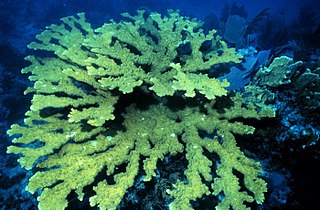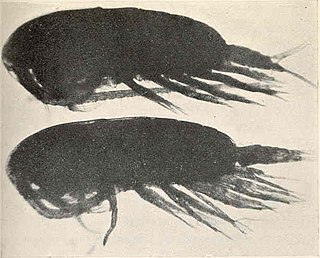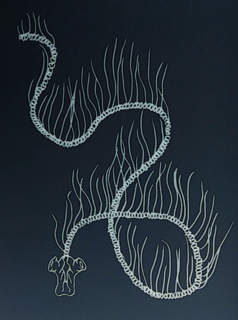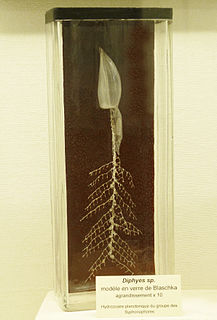
Zooplankton are heterotrophic plankton. Plankton are organisms drifting in oceans, seas, and bodies of fresh water. The word zooplankton is derived from the Greek zoon (ζῴον), meaning "animal", and planktos (πλαγκτός), meaning "wanderer" or "drifter". Individual zooplankton are usually microscopic, but some are larger and visible to the naked eye.

The Portuguese man o' war, also known as the man-of-war, bluebottle, or blue bottle jellyfish, is a marine hydrozoan found in the Atlantic Ocean and the Indian Ocean. It is considered to be the same species as the Pacific man o' war, which is found mainly in the Pacific Ocean.

Siphonophorae is an order of Hydrozoans, a class of marine organisms belonging to the phylum Cnidaria. According to the World Register of Marine Species, the order contains 175 species.

Glaucus atlanticus is a species of small, blue sea slug, a pelagic aeolid nudibranch, a shell-less gastropod mollusk in the family Glaucidae.

Phyllorhiza punctata is a species of jellyfish, also known as the floating bell, Australian spotted jellyfish, brown jellyfish or the white-spotted jellyfish. It is native to the western Pacific from Australia to Japan, but has been introduced widely elsewhere. It feeds primarily on zooplankton. P. punctata generally can reach up to 50 centimetres (20 in) in bell diameter, but in October 2007, one 72 cm (28 in) wide, perhaps the largest ever recorded, was found on Sunset Beach, North Carolina.

Elkhorn coral is an important reef-building coral in the Caribbean. The species has a complex structure with many branches which resemble that of elk antlers; hence, the common name. The branching structure creates habitat and shelter for many other reef species. Elkhorn coral is known to grow quickly with an average growth rate of 5 to 10 cm per year. They can reproduce both sexually and asexually, though asexual reproduction is much more common and occurs through a process called fragmentation.

Calanus finmarchicus is a species of copepods and a part of zooplankton, which is found in enormous amounts in the northern Atlantic Ocean.

The Praya dubia, or giant siphonophore, is an invertebrate which lives in the deep sea at 700 m (2,300 ft) to 1,000 m (3,300 ft) below sea level. It has been found off the coasts around the world, from Iceland in the North Atlantic, to Chile in the South Pacific.

Gelatinous zooplankton are fragile animals that live in the water column in the ocean. Their delicate bodies have no hard parts and are easily damaged or destroyed. Gelatinous zooplankton are often transparent. All jellyfish are gelatinous zooplankton, but not all gelatinous zooplankton are jellyfish. The most commonly encountered organisms include ctenophores, medusae, salps, and Chaetognatha in coastal waters. However, almost all marine phyla, including Annelida, Mollusca and Arthropoda, contain gelatinous species, but many of those odd species live in the open ocean and the deep sea and are less available to the casual ocean observer. Many gelatinous plankters utilize mucous structures in order to filter feed. Gelatinous zooplankton have also been called "Gelata".

Aurelia is a genus of scyphozoan jellyfish, commonly called moon jellies. There are currently 25 accepted species and many that are still not formally described.

Marrus orthocanna is a species of pelagic siphonophore, a colonial animal composed of a complex arrangement of zooids, some of which are polyps and some medusae. It lives in the Arctic and other cold, deep waters, swimming independently in mid-ocean. It is a colonial creature that is born from a single egg which is fertilized. Later on, a protozoan form that eventually grows to form more duplicating members of the colony.

Thetys vagina, or the twin sailed Salp, is the largest known solitary species of salp and the only valid species of the genus Thetys. First described by W.G Tilesius in 1802, the species is transparent and gelatinous, making it difficult to be seen in water, which is helpful in avoiding predators. The fossil range is very recent. Other animals often mistaken for T. vagina are Salpa fusiformis, Aurelia aurita, and Pegea confoederata. There is no known status of conservation in this species. T. vagina DNA was sequenced as part of a larger project in 2014 where spiny lobster larvae were found attached to T. vagina and consuming it.

Paragorgia arborea is a species of coral in the family Paragorgiidae, commonly known as the bubblegum coral because of its bulbous branch tips. It mainly grows in depths between 200 and 1,300 metres at temperatures between 3 and 8 °C. It is found widespread in the Northern Atlantic Ocean and Northern Pacific Ocean on seamounts and knolls, and was first described by the Swedish naturalist Carl Linnaeus in 1758. P. arborea is a foundation species, providing a habitat for other species in deep sea coral ecosystems.

Parasagitta setosa is a small arrow worm in the family Sagittidae, previously referred to as Sagitta setosa. It is native to the northeastern Atlantic Ocean, the North Sea and the Mediterranean Sea, and also occurs in the Baltic Sea and the Black Sea.

The Diphyidae are a family of siphonophores. These are colonial siphonophores with two nectophores arranged one behind the other. The front one includes a somatocyst, while the hind one does not. The somatocyst often contains an oil droplet for buoyancy control. A nectosac in each nectophore allows the organism to swim efficiently.

Muggiaea is a genus of siphonophores in the family Diphyidae. Members of this family are colonial siphonophores with two nectophores arranged one behind the other, but in the genus Muggiaea, the posterior nectophore is absent. The anterior one has a complete dorsal ridge. The somatocyst is very close to the nectosac wall.

Muggiaea atlantica is a species of small hydrozoan, a siphonophore in the family Diphyidae. It is a cosmopolitan species occurring in inshore waters of many of the world's oceans, and it has colonised new areas such as the North Sea and the Adriatic Sea. It is subject to large population swings, and has been held responsible for the death of farmed salmon in Norway. The species was first described by J.T. Cunningham in 1892 from a specimen obtained at Plymouth, England.

Bathyphysa conifera, sometimes called the flying spaghetti monster, is a bathypelagic species of siphonophore in the family Rhizophysidae.

Calycophorae is a suborder of siphonophores. The order includes the giant siphonophore, ; one of the longest lengthwise extant creatures (40–50m).

Compared to terrestrial environments, marine environments have biomass pyramids which are inverted at the base. In particular, the biomass of consumers is larger than the biomass of primary producers. This happens because the ocean's primary producers are tiny phytoplankton which grow and reproduce rapidly, so a small mass can have a fast rate of primary production. In contrast, many significant terrestrial primary producers, such as mature forests, grow and reproduce slowly, so a much larger mass is needed to achieve the same rate of primary production.


















